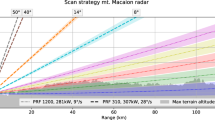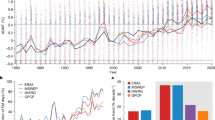Abstract
Automatic weather stations are essential for fine-grained weather forecasting; they can be built almost anywhere around the world and are much cheaper than radars and satellites. However, these scattered stations only provide partial observations governed by the continuous space–time global weather system, thus introducing thorny challenges to worldwide forecasting. Here we present the Corrformer model with a novel multi-correlation mechanism, which unifies spatial cross-correlation and temporal auto-correlation into a learned multi-scale tree structure to capture worldwide spatiotemporal correlations. Corrformer reduces the canonical double quadratic complexity of spatiotemporal modelling to linear in spatial modelling and log-linear in temporal modelling, achieving collaborative forecasts for tens of thousands of stations within a unified deep model. Our model can generate interpretable predictions based on inferred propagation directions of weather processes, facilitating a fully data-driven artificial intelligence paradigm for discovering insights for meteorological science. Corrformer yields state-of-the-art forecasts on global, regional and citywide datasets with high confidence and provided skilful weather services for the 2022 Winter Olympics.
This is a preview of subscription content, access via your institution
Access options
Access Nature and 54 other Nature Portfolio journals
Get Nature+, our best-value online-access subscription
$29.99 / 30 days
cancel any time
Subscribe to this journal
Receive 12 digital issues and online access to articles
$119.00 per year
only $9.92 per issue
Buy this article
- Purchase on Springer Link
- Instant access to full article PDF
Prices may be subject to local taxes which are calculated during checkout





Similar content being viewed by others
Data availability
The Global datasets are available from the National Oceanic and Atmospheric Administration (NOAA) at https://www.ncei.noaa.gov/data/global-hourly/access, which have been processed and deposited in our GitHub repository https://github.com/thuml/Corrformer. The partial set of the regional and Olympics datasets can be obtained from the CMA website http://data.cma.cn/data after registration as real-name users. The complete set was used under license for the current study and is available from the authors upon reasonable request and with permission from the CMA. The map data are made with Natural Earth.
Code availability
The code is available on Code Ocean at https://doi.org/10.24433/CO.1753465.v1 (ref. 41), which is also on GitHub at https://github.com/thuml/Corrformer or https://doi.org/10.5281/zenodo.7866837.
References
Palmer, T. Climate forecasting: build high-resolution global climate models. Nature. 515, 338–339 (2014).
Phillips, N. A. The general circulation of the atmosphere: a numerical experiment. Q. J. R. Meteorolog. Soc 82, 123–164 (1956).
Jacox, M. G. et al. Global seasonal forecasts of marine heatwaves. Nature. 604, 486–490 (2022).
Gao, Z. et al. Earthformer: exploring space-time transformers for earth system forecasting. In 36th Conference on Neural Information Processing Systems (NeurIPS, 2022).
Chatfield, C. The Analysis of Time Series: An Introduction (Chapman and Hall/CRC, 1981).
Papoulis, A. & Saunders, H. Probability, Random Variables and Stochastic Processes (McGraw-Hill Education, 1989).
Krishnamurti, T. N. & Bounoua, L. An Introduction to Numerical Weather Prediction Techniques (CRC Press, 1996).
McGuffie, K. & Henderson-Sellers, A. The Climate Modelling Primer (John Wiley and Sons, 2014).
Reichstein, M. et al. Deep learning and process understanding for data-driven earth system science. Nature. 566, 195–204 (2019).
Wu, H., Xu, J., Wang, J. & Long, M. Autoformer: decomposition transformers with auto-correlation for long-term series forecasting. In 35th Conference on Neural Information Processing Systems Vol. 34, 22419–22430 (NeurIPS, 2021).
Robert, C., William, C. & Irma, T. STL: a seasonal-trend decomposition procedure based on loess. J. Off. Stat. 6, 3–73 (1990).
Berg, M. Applied General Statistics (Prentice-Hall, 2016).
Dietrich, C. F. Uncertainty, Calibration and Probability: The Statistics of Scientific and Industrial Measurement (Routledge, 1973).
Park, K. I. Fundamentals of Probability and Stochastic Processes with Applications to Communications (Springer, 2017).
Chou, Y.-L. Statistical Analysis, with Business and Economic Applications (Holt, Rinehart and Winston, 1975).
Sutton, G. Weather forecasting: the future outlook. Nature 176, 993–996 (1955).
Nielsen, F. Introduction to HPC with MPI for Data Science (Springer, 2016).
Rokach, L. & Maimon, O. in Data Mining and Knowledge Discovery Handbook Ch. 15 (Springer, 2005).
Wiener, N. Generalized harmonic analysis. Acta Math 55, 117–258 (1930).
van den Oord, A. et al. WaveNet: a generative model for raw audio. In Proc. 9th ISCA Workshop on Speech Synthesis Workshop (ISCA, 2016).
Hersbach, H. et al. The ERA5 global reanalysis. Q. J. R. Meteorolog. Soc. 146, 1999–2049 (2020).
Dee, D. P. et al. The ERA-Interim reanalysis: configuration and performance of the data assimilation system. Q. J. R. Meteorolog. Soc. 137, 553–597 (2011).
Global Forecast System (NOAA, accessed 1 July 2022); https://www.ncei.noaa.gov/
Bauer, P., Thorpe, A. & Brunet, G. The quiet revolution of numerical weather prediction. Nature 525, 47–55 (2015).
Kendall, M. Time-Series 2nd edn (Griffin, 1976).
Hyndman, R. J. & Athanasopoulos, G. Forecasting: Principles and Practice (OTexts, 2018).
Ke, G. et al. LightGBM: a highly efficient gradient boosting decision tree. In 31st Conference on Neural Information Processing Systems (NeurIPS, 2017).
Taylor, S. J. & Letham, B. Forecasting at scale. Am. Stat. 72, 37–45 (2018).
Salinas, D., Flunkert, V., Gasthaus, J. & Januschowski, T. DeepAR: probabilistic forecasting with autoregressive recurrent networks. Int. J. Forecast. 36, 1181–1191 (2020).
Li, S. et al. Enhancing the locality and breaking the memory bottleneck of transformer on time series forecasting. In 33rd Conference on Neural Information Processing Systems (NeurIPS, 2019).
Oreshkin, B. N., Carpov, D., Chapados, N. & Bengio, Y. N-BEATS: neural basis expansion analysis for interpretable time series forecasting. In International Conference on Learning Representations https://openreview.net/forum?id=r1ecqn4YwB (2019).
Beltagy, I., Peters, M. E. & Cohan, A. Longformer: the long-document transformer. Preprint at https://arxiv.org/abs/2004.05150 (2020).
Lee-Thorp, J., Ainslie, J., Eckstein, I. & Ontanon, S. FNet: mixing tokens with Fourier transforms. In Proceedings of the 2022 Conference of the North American Chapter of the Association for Computational Linguistics: Human Language Technologies 4296–4313 (Association for Computational Linguistics, 2022).
Zhou, H. et al. Informer: beyond efficient transformer for long sequence time-series forecasting. In Proceedings of the AAAI Conference on Artificial Intelligence Vol. 35, 11106–11115 (AAAI, 2021).
Liu, S. et al. Pyraformer: low-complexity pyramidal attention for long-range time series modeling and forecasting. In International Conference on Learning Representations https://openreview.net/forum?id=0EXmFzUn5I (2022).
Zhou, T. et al. FEDformer: frequency enhanced decomposed transformer for long-term series forecasting. In International Conference on Machine Learning (PMLR, 2022).
Woo, G., Liu, C., Sahoo, D., Kumar, A. & Hoi, S. ETSformer: exponential smoothing transformers for time-series forecasting. Preprint at https://arxiv.org/abs/2202.01381 (2022).
Challu, C. et al. N-Hits: neural hierarchical interpolation for time series forecasting. In Proceedings of the AAAI Conference on Artificial Intelligence Vol. 37 (AAAI, 2023).
Sun, F.-K. & Boning, D. S. FreDo: frequency domain-based long-term time series forecasting. Preprint at https://arxiv.org/abs/2205.12301 (2022).
Cao, D. et al. Spectral temporal graph neural network for multivariate time-series forecasting. In 33rd Conference on Advances in Neural Information Processing Systems Vol. 33, 17766–17778 (NeurIPS, 2020).
Wu, H. et al. Code of interpretable weather forecasting for worldwide stations with a unified deep model. CodeOcean https://doi.org/10.24433/CO.1753465.v1 (2023).
Acknowledgements
All research described in this paper was funded by the National Key Research and Development Project through grant 2021YFC3000905 (M.L.) and the National Natural Science Foundation of China through grants 62021002 (J.W.) and 62022050 (M.L.). We thank our colleagues from the CMA, including B. Bi, K. Dai and Y. Gong, for their suggestions and support for the paper.
Author information
Authors and Affiliations
Contributions
M.L. conceived and designed the project. H.W. and M.L. developed the Corrformer model and wrote the paper. H.W. and H.Z. implemented all of the methods, processed the data, conducted the experiments, analysed the results and validated the Winter Olympics weather cases. M.L. supervised the work, investigated the methodology and accepted responsibility for the overall integrity of the paper. J.W. revised and approved the paper and provided the research environment and funding support.
Corresponding authors
Ethics declarations
Competing interests
The authors declare no competing interests.
Peer review
Peer review information
Nature Machine Intelligence thanks Boris Oreshkin, Danielle Robinson and Tobias Finn for their contribution to the peer review of this work.
Additional information
Publisher’s note Springer Nature remains neutral with regard to jurisdictional claims in published maps and institutional affiliations.
Extended data
Extended Data Fig. 1 Forecasting of global temperature.
Forecasting of global temperature from 2020-08-19 19:00:00 to 2020-08-20 19:00:00. A brighter pixel indicates a higher temperature. The changing part is highlighted in red dotted boxes for readability. Corrformer can generate a more accurate prediction in temperature for each station and also accurately capture temperature changes along the longitude over time.
Extended Data Fig. 2 Forecasting of global wind.
Forecasting of global wind from 2020-10-24 19:00:00 to 2020-10-25 19:00:00. A brighter pixel indicates a stronger wind. The changing part is highlighted in red dotted boxes for readability. Comparing to other baselines, Corrformer performs better in the prediction of mean and extreme values.
Extended Data Fig. 3 Single station case studies.
We plot the predictions of different models from the single station view. We can find that Corrformer surpasses the other baselines in both seasonal and peak value modeling. Especially, for the Olympics Wind, Corrformer can capture the weakening phase of the wind speed well, which is meaningful for scheduling competitions between strong winds.
Extended Data Fig. 4 Model efficiency analysis.
We fix the bath size to 1 and model channels to 512, then record the change curves of GPU memory and running time when the number of stations increases. Specifically, the running time is averaged from 1,000 iterations. Corrformer presents linear complexity in both memory and running time w.r.t. the number of stations.
Extended Data Fig. 5 Model adaptability analysis.
Corrformer is trained on roughly 10% stations, that is, 350 stations for the Global dataset and 3,404 stations for the Regional dataset, and further evaluated on the large dataset with progressively added new stations. Corrformer can adapt to newly added stations seamlessly with no need to re-train.
Supplementary information
Supplementary Information
Supplementary Figs. 1–4, Tables 1–13, ablations and related work.
Rights and permissions
Springer Nature or its licensor (e.g. a society or other partner) holds exclusive rights to this article under a publishing agreement with the author(s) or other rightsholder(s); author self-archiving of the accepted manuscript version of this article is solely governed by the terms of such publishing agreement and applicable law.
About this article
Cite this article
Wu, H., Zhou, H., Long, M. et al. Interpretable weather forecasting for worldwide stations with a unified deep model. Nat Mach Intell 5, 602–611 (2023). https://doi.org/10.1038/s42256-023-00667-9
Received:
Accepted:
Published:
Issue Date:
DOI: https://doi.org/10.1038/s42256-023-00667-9



